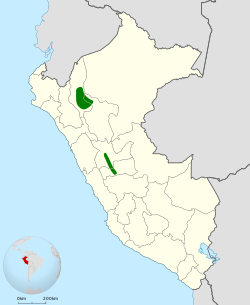Top Qs
Timeline
Chat
Perspective
Chestnut antpitta
Species of bird From Wikipedia, the free encyclopedia
Remove ads
The chestnut antpitta (Grallaria blakei) is a species of bird in the family Grallariidae. It is endemic to Peru.[2]
Remove ads
Taxonomy and systematics
The chestnut antpitta has always been regarded as monotypic.[2] A study published in 2020 showed that two populations of it were actually separate species, the Oxapampa antpitta (G. centralis) and Ayacucho antpitta (G. ayacuchensis).[3] By mid-2022 the International Ornithological Committee, the Clements taxonomy, and the South American Classification Committee of the American Ornithological Society had recognized the two new species, significantly reducing the range attributed to the chestnut antpitta.[4][5][6] However, as of early 2024 BirdLife International's Handbook of the Birds of the World (HBW) had not recognized them.[7]
Remove ads
Description
The chestnut antpitta is about 14.5 to 15 cm (5.7 to 5.9 in) long; six individuals weighed between 37 and 47 g (1.3 and 1.7 oz). The sexes have the same plumage. Adults have rufous brown upperparts. Their lores and most of their face are rufous. Their throat and breast are pale rufous, their belly whitish buff with obscure dusky barring, their flanks brown or olive brown, and their vent and undertail coverts tawny brown. They have a brown iris, a black bill, and slate, blue-gray, or silvery gray legs and feet.[8][9]
Remove ads
Distribution and habitat
The chestnut antpitta is found intermittently on the eastern slope of the Peruvian Andes from the Cordillera de Colán in Amazonas Department south for an unknown distance but short of northern Huánuco Department. It inhabits humid montane forest and secondary forest where it favors stands of bamboo and other dense undergrowth.[8][9]
Behavior
Movement
The chestnut antpitta is believed to be a year-round resident throughout its range.[8]
Feeding
The chestnut antpitta's diet and foraging behavior have not been detailed; it is assumed to eat arthropods and perhaps small vertebrates as do other members of genus Grallaria . It is known to forage on or very near the ground.[8]
Breeding
Nothing is known about the chestnut antpitta's breeding biology.[8]
Vocalization
The chestnut antpitta's song is "a rapid, monotone, slightly accelerating series of chiming notes: chew'chu'uuuuuuuu'uuu".[9]
Remove ads
Status
The IUCN follows HBW taxonomy and so its assessment of the chestnut antpitta includes the Oxapampa and Ayacucho antpittas. That species sensu lato is assessed as being of Least Concern.[1] It is considered "locally fairly common".[9]
References
Wikiwand - on
Seamless Wikipedia browsing. On steroids.
Remove ads




